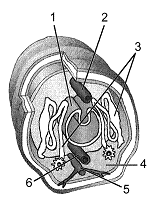A tunicate is in which phylum?
The free-swimming tunicate larva resembles a tadpole. Once it settles headfirst onto a solid surface the tail and notochord disappear, and the nerve cord shrinks to nearly nothing. The adults, which are usually sessile, retain only the pharyngeal slits. Neither adult nor larva is segmented.
A. Annelids
B. Nematodes
C. Chordates
D. Mollusks
E. Echinoderms
C. Chordates
You might also like to view...
The cross section in Figure 31-6 is representative of the internal structures found in:

A. phoronids.
B. nemerteans.
C. Diplopoda.
D. Polyplacophora.
E. oligochaetes
In a healthy kidney, which of the following would you NOT expect to find in the filtrate?
A) Large proteins B) Water C) Salt D) Glucose E) Drugs
Assume you inoculated 100 cells, with a generation time of 20 minutes, into 100 ml of nutrient broth. You then inoculated 100 cells of the same species into 200 ml of nutrient broth. After incubation for 4 hours, you can reasonably expect to have
A) more cells in the 100 ml. B) more cells in the 200 ml. C) the same number of cells in both. D) The answer cannot be determined based on the information provided.
Soil and dirt are terms can be used interchangeably. Soil is only made up of non-living minerals and weathered rock
A. True B. False